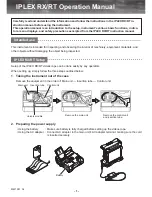
Installation, Operation and Service Manual
LKP Series 4 Channel OEM
© 2019 DynAmp, LLC
Page 15
041593O
of measured current. The wire should have an insulation rating of 600Vac and 80°C
minimum temperature rating.
If an external transformer is being used to supply power to the Metering Unit, consider
sizing the transformer to 30VA/kA. Over-sizing the transformer will keep its temperature
rise to a minimum due to the harmonic rich content of the AC current drawn by the
Metering Unit.
Transformers are required when totalizing two or more Metering Units into one shunt,
External isolation transformers are required at the meter AC supply. If an isolation
transformer is used both input lines must be fused.
NOTE
In rare instances, one of more LKP Series 4 Channel OEM units in a totalized system will “lock-
on”. This phenomenon is not due to component failure in individual units, but is the result of
incorrect connections in the system output circuit. The most common mistake when connecting
the LKP Series 4 Channel OEM units is the use of one return conductor from the point of
totalizing, to several Metering Units (terminal TB1-23). This connection results in a slight
positive voltage appearing at the anodes of one or more internal thyristors.
4.9 INITIAL SYSTEM CHECKOUT
Recheck all wiring connections against the drawings to ensure proper installation. When
satisfactory, turn on the system by first closing the external breaker or disconnect.
With the bus energized, the Metering Unit’s output in use should accurately measure the bus
current. The ratio between bus current and the output feedback current is 5000:1. If a test
ammeter is not used, read the current indicator across the shunt of the output circuit.
It is necessary to take a complete set of channel voltage readings. These readings serve two
purposes: one, to verify that all channels are operating properly and; two, to aid in magnetic
centering of the Measuring Head. With the bus current operating at its highest operating level,
take two sets of readings, the first set taken immediately (to verify no condition exists that may
cause damage to the LKP Metering Unit), and the second set preferably after a 24-hour period
of time (to thermally stabilize the head). Proceed as follows:
A.) The dc voltage range may be as high as 75 Vdc (see point “D” below). Make certain the
voltmeter being used is set to measure average dc volts in this range.
B.) The measured bus and all other high current buses in the vicinity (within a 10 meter radius)
should be operating at or near their highest levels. Note: All magnetic field sources will
affect the channel voltage readings.
C.) Make a photocopy of “Form for Recording Channel Voltage Measurements” Table 4.3. The
initial readings are made as instructed on the form, and are recorded in the individual
blocks. Refer to the head schematic drawing in the back of the manual, which graphically
show the channel locations on the head.
D.) Excluding the effects of external magnetic sources and assuming a full rated bus current,
each channel is expected (by calculation) to measure approximately 15 V to 25Vdc. In
practice, channel readings should be more on the order of 10 V to 30 Vdc, but that may not
be achievable. A channel failure will usually be indicated by either a full-off (near zero),
half-on (35-38 V) or full- on (70-75 V) condition.
















































